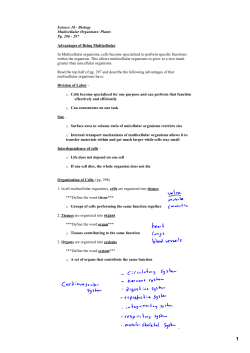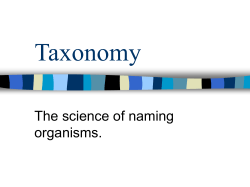
Electromechanical Design with Heterogeneous Modules
Multicellular Machines: Electromechanical Design with Heterogeneous Modules Robert MacCurdy1,2 and Hod Lipson2 Abstract Robots have been constructed with diverse morphological and topological configurations, making comparisons between efforts, or assessments of new areas for exploration difficult. Here we propose the use of a phylogenetic tree based on biological organisms to classify developments in robotics using a comparative analysis. Comparisons between robots and organisms at the family or genus level based on morphology, topology and behavior were used to populate a tree, and this tree exhibited a conspicuous absence of robots at the nodes that correspond to multicellular organisms. This led us to investigate a new area for robotics research: multicellular machines. Distinguished from previous efforts in modular robotics by the extreme simplicity of the modules, and the large number of modules and module types, multicellular machines can leverage bioinspired developmental processes[1], [2] to automatically design machines with embodied computation (McNicoll, unpublished), actuation [3], and that are amenable to automated fabrication [4]. The same multicellular approach, combined with conventional additive manufacturing techniques, enables sophisticated electrical functionality to be embedded within a 3D printed object, sidestepping many barriers to printed electronics (MacCurdy, unpublished). Additionally, though multicellularity has been rediscovered by natural evolution at least 25 times [5], the optimal number of module classes for a particular functionality or body size is unknown; observations of natural systems show a power law relationship between body size and number of cell types, though the fit is not strong (R2 = 0.25) [6]. Experiments in the artificial evolution of multicellular systems might elucidate the role that multicellularity plays in niche exploitation. Vacant positions hint at new areas for exploration Bilateria Eumetazoa Thaliacea Eukaryota Chordata Fig. 1. Clockwise from upper left: A Phylogenetic tree, based on biological organisms, used to classify existing efforts in robotics and hint at new areas for exploration; A new synthetic cell/module type with an ant for scale; Several different modules have been produced - the ”best” number of cell types is unknown; An Infra-Red remote control implemented with these cells, demonstrating their use in 3D-printed electronics; A 2-DOF leg. R EFERENCES [1] K. O. Stanley, Genetic Programming and Evolvable Machines 8, 131 (2007). [2] S. B. Carroll, Philosophy of Biology: An Anthology p. 193 (2009). [3] N. Cheney, R. MacCurdy, J. Clune, H. Lipson, Proceedings of the15th annual conference on genetic and evolutionary computation (GECCO) (2013). [4] R. MacCurdy, A. McNicoll, H. Lipson, International Journal of Robotics Research 33, 1342 (2014). [5] R. K. Grosberg, R. R. Strathmann, Annual Review of Ecology, Evolution, and Systematics pp. 621–654 (2007). [6] G. Bell, A. O. Mooers, Biological Journal of the Linnean Society 60, 345 (1997). 1 - Distributed Robotics Lab, CSAIL, MIT. 2 - Creative Machines Lab, Cornell U. Contact: maccurdy@mit.edu
© Copyright 2025





















